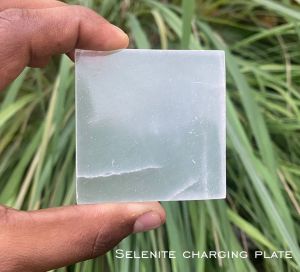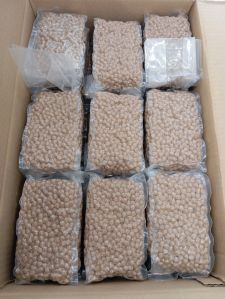
White Pearl Gemstone
100 - 2,000 Per carat
1 Piece (MOQ)

Moneycode Stone
Get Price Quote
2 Ton (MOQ)
Best Deals from Gemstones

Selenite Crystals Charging Plate
650 Per piece

Black Sugar Tapioca Pearl
150 - 155 Per kg
27360 K (MOQ)
A black sugar tapioca pearl, also known as black sugar tapioca ball, is an edible translucent sphere produced from tapioca, a starch made from the cassava root. They originated as a cheaper alternative to sago in Southeast Asian cuisine. When used as an ingredient in bubble tea, they are most commonly referred to as pearls or boba. The starch pearls are typically five to ten millimeters (0.2 to 0.4 inches) in diameter. By adding different ingredients, like water, sugar, or some other type of sweetener like honey, tapioca pearls can be made to vary in color and in texture. Various forms of tapioca pearls include black, flavored, popping, mini, and clear. Tapioca pearls are commonly soaked in sugar syrup to make them sweet and chewy. In teas, they are often added for their texture, with the flavor being provided by the drink itself.

Metal Hair band moti
55 Per Dozen

Tb Healing stone (Lapis Lazuli)
Get Price Quote
Purchasers will not be disappointed buying our range of product, as it adheres to industrial quality regulation systems. We are a noteworthy name and work hard to attain complete client satisfaction. And, for achieving this objective, we facilitate them with easy payment modes.

NATURAL UNTREATED AGATE HEART GEMSTONE
Get Price Quote

Rough Natural Gem Stones
Get Price Quote

Rough Gemstone
Get Price Quote

Emerald Stone
Get Price Quote
Our clients can avail high quality Emerald Stone, which is Manufactured, Exported and Supplied by us. We consider client satisfaction as priority and to assure this, we provide these high quality Emerald Stones at affordable price range. Gemstones : Emerald (Beryl) Source : Afghanistan, Brazil, Canada (Regal Ridge), Columbia, Madagascar, Pakistan, Zambia Birthstone : May The name "Emerald" (French: Emeraude, German: Smaragd, Spanish: Esmeralda) comes from the Greek word smaragdos; a name that was given to several gemstone minerals having little in common chemically, but sharing a similar bluish-green color. An emerald is a form of Beryl, a mineral group that includes aquamarine and Morganite. Emerald's leaf-green color is partially due to allochromatic coloration from trace amounts of chromium (Cr) and vanadium (V) impurities. Emerald is transparent to translucent member of the beryl family of minerals (aquamarine, morganite, goshenite, red beryl), and is typically associated with igneous rock. Emerald is a cyclosilicate of beryllium and aluminium, and owes its green color to chromium and vanadium, along with other trace coloring agents which include beryllium (berillium) (Be) aluminum silicate and iron (Fe). Heaxagonal Prism Flat & Beryl Crystal habit Many varieties of emerald have a leaf-green to yellowish-green hue, but Columbian emeralds form Muzo and Chivor have a particularly intense greenish hue with a bluish-green overtones, which makes their color very difficult to capture in photographic images. Emerald Inclusions : Jardin Emerald is one of the most difficult gemstones to cut because of the many fluid inclusions found in rough crystals which can make them very brittle. These multiphase inclusions are like fingerprints and can reveal the geographic location of their origin. The French refer to the large number of inclusions in the stone as "jardin," or "garden," because they can resemble plant foliage. These inclusions can be two-phase tubes that run parallel to the c-axis, or two to three-phase secondary healed fractures or basal cleavages. Emeralds with many inclusions should be treated with care and be protected from direct blows to the stone. Oils are commonly used to fill-in the fissures (see "emerald enhancements" below). The extreme rarity of transparent, inclusion-free emeralds can make them more valuable than diamonds. Emerald (Beryl) Crystallography, Chemistry, Physical Properties Crystal System - hexagonal Crystal Habit - hexagonal prism, pincoid terminationsSpecific gravity (SG) - 2.67 to 2.78Mohs Hardness Scale - 7.5 to 8.0Toughness - fair to poor Fracture - conchoidal Cleavage - poor, basal Streak - white Chemical Composition - Al2Be3[Si6O18] Emerald (Beryl) Optical Properties Optical Properties - double refraction Refractive Index - 1.576 - 1.583Birefringence - 0.005 - 0.009 Pleochroism - distinct (w=yellowish-green, e=green) Surface Luster - vitreousDiaphaneity - transparent to opaque Gem Color - green, bluish-green, greenish-blue, yellowish-green Ancient Egyptian Emerald Mining The ancient Egyptian, Babylonian, Roman and Byzantine cultures obtained their emeralds from the Sikair-Zubara (Sikait-Zabara) region in the eastern part of Upper Egypt, near the Red Sea town of Berenice. This emerald-mining region became known as the Mons Smaragdus or 'Emerald Mountains" and after the conquest of Alexander the Great, and was also referred to as the "Cleopatra Mines" in latter years. Cleopatra Mines in Egypt : Sikair-Zubara The Egyptian mines may have been worked as early as 1800 BC, but most likely were at peak production during the Ptolemaic period from 330 BC to 30 BC. The first mines to be re-discovered were at Gebel Zabara, uncovered on an expedition by French mineralogist F. Cailliaud, in 1816. Sikait was identified two years later. The Wadi Gimal and Wadi Sikait mines are adjacent to the ancient roman mining villages of Nugrus and Sikkait. Colombian Emerald - The Gemstones of 'El Dorado' - Colombia: Chivor, Coscuez, Muzo & Trapiche Emeralds Dating back as far as 10,000 BC, tribes of hunter-gatherers traded with one another along the Magdalena River Valley, in what is now northern Colombia. The Chibchas, Cañaris and Muisca peoples of the Boyacá and Cundinamarca highlands were one of the first pre-Columbian civilizations to settle along the tropical Magdalena Valley, ruled by the two kings, Zipa (of the south, near Bogotá) and Zaque (of Hunza in the north). Tales of riches from the mythical kingdom of El Dorado, meaning the "golden one" or "gilded man" (aka: el indio dorado or "the golden Indian," el rey dorado or "the golden king") drove Spanish Conquistadors like Hernando Cortés, Francisco Pizarro, and Sebastian de Belalcazar to explore, and ultimately conquer this region in the early 1500s. Map of Boyacá Mines : Laguna de Guatavita (c. 1860) Belalcazar's legendary tales of Cañaris and Muisca kings being coated with "sticky earth," then painted with gold dust and emeralds; or of emeralds and gold being thrown into Laguna de Guatavita (above and below, right) as a sacrafice to the gods, were enough motivation to find the source for such wealth. Although Laguna de Guatavita is located in the modern-day municipality of Sesquilé, Colombia, the "golden city" of El Dorado is believed to have been either the Incan city of Coricancha (meaning "Golden Courtyard") in modern-day Cusco, Peru, or at the location of the Incan city of Tomipamba, which later became the Colonial city of Cuenca ( Santa Ana de los cuatro rÃos de Cuenca), in Azuay Province, Ecuador. Wherever the actual location of El Dorado may have been, the quest for its ultimate riches, and the source location for the Guilded Man's emeralds would elude the Spaniards for decades. The native Muisca Indians had carefully concealed the openings to their underground resting place, allowing the jungle to obliterate any remaining evidence of their whereabouts. Even torture was employed, but to no avail [5]. In 1555 however, the emerald mines of Muzo were finally uncovered. In 1580, Conquistador Antonio de Sepulvada even attempted to drain Guatavita (located in Sesquilé, Cundinamarca) by cutting a channel in one side of the crater-lake's rim, in order to salvage the imagined treasures that lay at its bottom. During this period, offerings of gold, and an emerald the size of a "hen's egg," were recovered from the shallower edges of the lake. The Spanish spent the next 200 hundred years plundering the wealth of the Boyacá highlands, undeterred until the early 1800s. The Spanish colonial territories of Viceroyalty and New Granada became the independent nation of Colombia in 1810, under the leadership of Simón BolÃvar. Emerald Mining in Colombia's 'Emerald Belt' Colombian emeralds are located in an area known as the 'Emerald Belt' (Cinturon EsmeraldÃfero). This area is in the sedimentary basin of the Cordillera Oriental mountain range in the Gobernación de Boyacá and Cundinamarca districts, at the base of the Andes Mountains. The Spanish Inquisition Necklace - Muzo Emerald Necklace Indian emeralds, with their distinct bluish hue, were found near Ajmer and Udaipur in north-western Rajasthan State. The Mughals of India, including the builder of the Taj Mahal, Shah Jahan, loved emeralds so much they inscribed them with sacred text and wore them as talismans. These sacred stones were called Mughal emeralds. Cordillera Oriental emeralds were created by hydro-thermal activity generated from the forces that created the Andes mountain range. Columbian emeralds tend to have more inclusions which are fairly light (jardin). The color tends to be darker than emeralds from other locations. The principle mining areas in Colombia are the Somondoco and Muzo mining regions northeast of the capital of Bogota. The richest emerald mines in the Muzo region are the Muzo Mine, Cosquez Mine, and Pena Blanca Mine. The Muzo Mackay Emerald Necklace - The Gachala Emerald from Muzo, Colombia One of the largest emeralds ever recorded was the 218 carat tablet-cut rectangular "Mogul Emerald," possibly belonging to the last great Mogul ruler of India, Emperor Aurangzeb from the late 1600s. The 858 carat "Gachala Emerald" (above, right), from the Vega de San Juan mine in Gachalá (municipio de Cundinamarca), is one of the largest emeralds found to date. It was unearthed in 1967, and donated to the Smithsonian Institution by Harry Winston. Muzo, Coscuez & Chivor Colombian Emeralds At the north-western end of the Colombian emerald-belt, mining is conducted in three districts: Coscuez, Muzo, and Quipama. Emerald from the Muzo region is mined under the control of the 'Sociedad de Mineros Boyancences,' with many of the mines (Cortes) being worked by unauthorized miners (guaqueros). Muzo emeralds are known for their characteristically leaf-green color called "Muzo Green." Notable mines in the Muzo/Coscuez region are the Yacopi mines and Peña Blanca (Peñas Blanca) deposits. At the south-eastern end of the emerald-belt, the Gachalá and Chivor region is mined mostly by private companies, and the Chivor stones have a bluish-green color similar to those mined in Zambia. Notable mines in the Chivor region are the Chivor, Matacana, Vega de San Juan, and Gachalá Mines. Trapiche Emeralds A very rare variety of emerald known as "Trapiche" (above), found at the Muzo, Chivor, Cosquez and Peña Blanca mines, has distinct carbonaceous shale inclusions that radiate from a hexagonal center point in a six-spoked star pattern. The name "Trapiché" (tra-pee-chee) comes from a type of wheel that is used to grind sugarcane in Colombia. Characteristics of Muzo Emeralds Typically, the transparency of Muzo emeralds is higher than emeralds from other regions, primarily due to due the lower volume of inclusions. Muzo emeralds tend to have a deeper, "herbaceous" green color. Muzo emeralds tend to have three-phase inclusions which contain fluid, gas vapor, as well as included crystals of calcite, halide, and yellow-brown rutile needles of parisite. Canadian Emerald Canadian emeralds were first discovered in 1998, in the 'Regal Ridge' area of the Yukon. Confirmation of the find at the University of British Columbia (UBC) created a 'emerald rush' to the area by several prominent mining companies. The first emeralds were found by Bill Wengzynowski, a prospector for Expatriate Resources in Vancouver. Although the color of the stones is considered to be exceptional, it is yet to been determined if mining in the area will be commercially feasible. In 2003 preliminary exploration of Regal Ridge was begun by True North Gems Inc., who is also investigating areas of Ontario. The Yukon property is now known as "Tsa da Glisza," located in the Finlayson mining district of the Yukon Territory, Canada. Tsa da Glisza is situated on a high alpine ridge of the Pelly Mountain range. Emerald Enhancements & Treatments Clarity enhancement and surface treatment of emeralds using glycerin, Canada balsam oil, cedar wood oil or clove oil impregnation is practiced universally. The only way to confirm that an emerald hasn't been oil treated is if the cut stone has no fractures at the surface for oil to enter into the stone. If an emerald is cleaned in an ultrasonic or steam cleaner the oil can leach out of the fractures. This will make the surfacing inclusions appear more obvious. If this occurs, the emerald can be re-oiled to fill in the fractures. Fractures can also be filled with Opticon Fracture Sealer which is an epoxy resin. Due to the typically high amount of inclusions within the stone, emerald has a lower durability than other varieties of beryl such as aquamarine. When an emerald is set in a ring with a prong setting extra care should be used. Emerald Simulants & Soude Emerald Simulated emeralds (simulants) made of glass or quartz are doublets or triplets with a transparent layer of green gelatin sandwiched between. These simulants are known as "soude emerald." A Chelsea Filter is used to differentiate and identify natural emeralds from simulants by isolating the chromium found in real emeralds, although some older soude emeralds may appear as red or pink. Synthetic Emerald Synthetic emerald was developed by Caltech graduate, Carroll Chatham in 1939. Synthetic emerald is created using the Flux-Growth, and Lechleitner Synthetic Overgrowth (hydro-thermal) methods and is sold under the trade names Chatham Created Gems and Gilson. Synthetic emerald can be identified by its characteristic inclusions. Initially, the only way to distinguish a Chatham emerald from a natural emerald was to heat the stone to the point where the natural stone would shatter due to moisture contained within the inclusions. Synthetic Emerald has a refractive index of 1.561.

Aqua-Marine, Aquaculture Pond Water Mineral
Get Price Quote
Mineral ions in water have demonstrated to have significant roles on the growth, productivity and survival of prawns & fish. Prawns, esp L.vannamei have been studied to be able to absorb minerals through their gills supplementing any deficiency in diet Ionic composition of water plays an important role in the balance of the aquaculture system. Aqua-Marine* presents critical minerals & ions in dispersible bioavailable forms. Aqua-Marine* is a concentrated form of essential macro & micro minerals for prawns & fish culture. Aqua-Marine* helps the prawn maintain osmotic pressure, by regulating exchange of water and solutes within the prawn body. Aqua-Marine* supplements vital minerals necessary for molting & shell formation thereby protecting from Loose Shell Syndrome (LSS) & alleviates from Tail cramping, soft shelling and incomplete molting of prawns. Aqua-Marine*dramatically improves feed efficiency, growth & survival

golden rutile
Get Price Quote
We are offering golden rutile.

Pearl
Get Price Quote

Pearl
Get Price Quote
caustic soda pearl, gacl hydrogen peroxide, Steel Name Plates

astrological gems
Get Price Quote
astrological gems, Gemstone Rings

Gemstones
Get Price Quote
Gemstones, Fashion Jewellery

Jasper Stone
Get Price Quote
Jasper Stone

Gomati Chakra
15 Per Piece
10 Piece(s) (MOQ)
We are the leading manufacturers, exporters and supplier of this products.

Granite Black Pearl
Get Price Quote
We are offering granite black pearl. One of the most popular granites black pearl. Its popularity is mainly due to its color. Anything that is black is a symbol of elegance and style. That is the same with this stone. One cannot escape the dark black color fused with silver, blue, green and grey. The mixture or combination of these colors on the dark black base is truly captivating. This granite has the ability to brighten up any room owing to its distinct color combination.

Topaz
Get Price Quote
Topaz, diamonds, colour stones, Ruby, sapphire diamonds